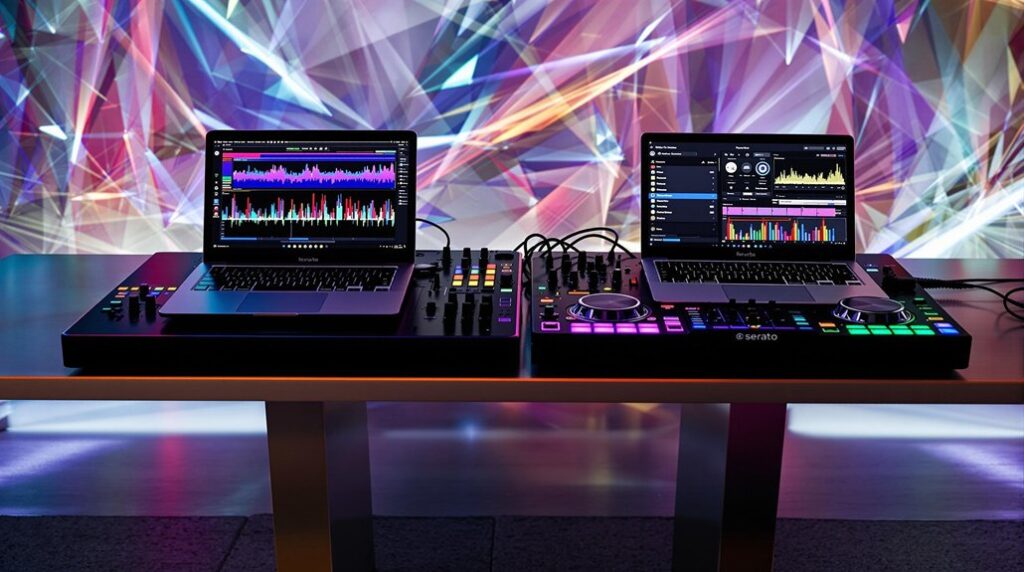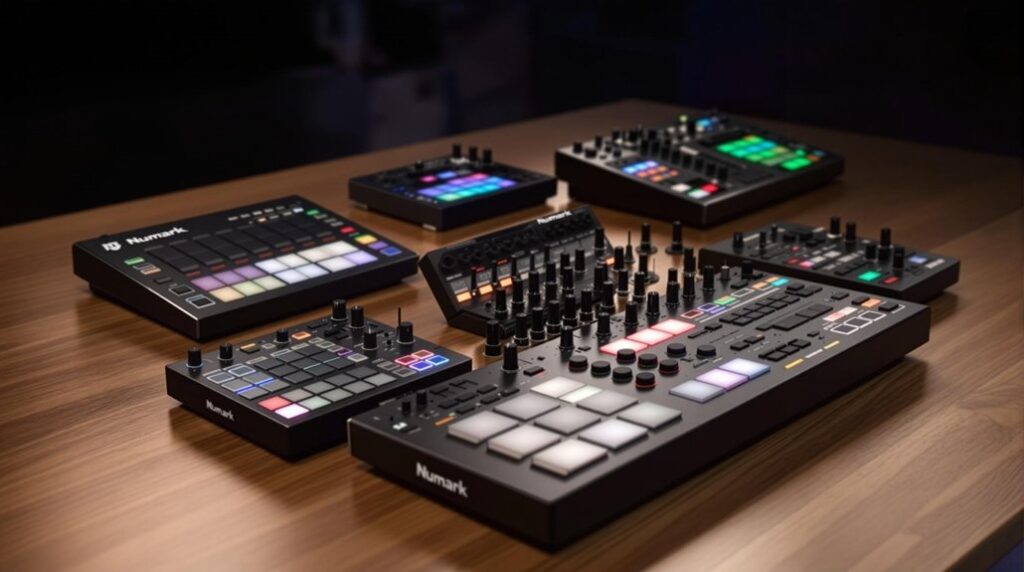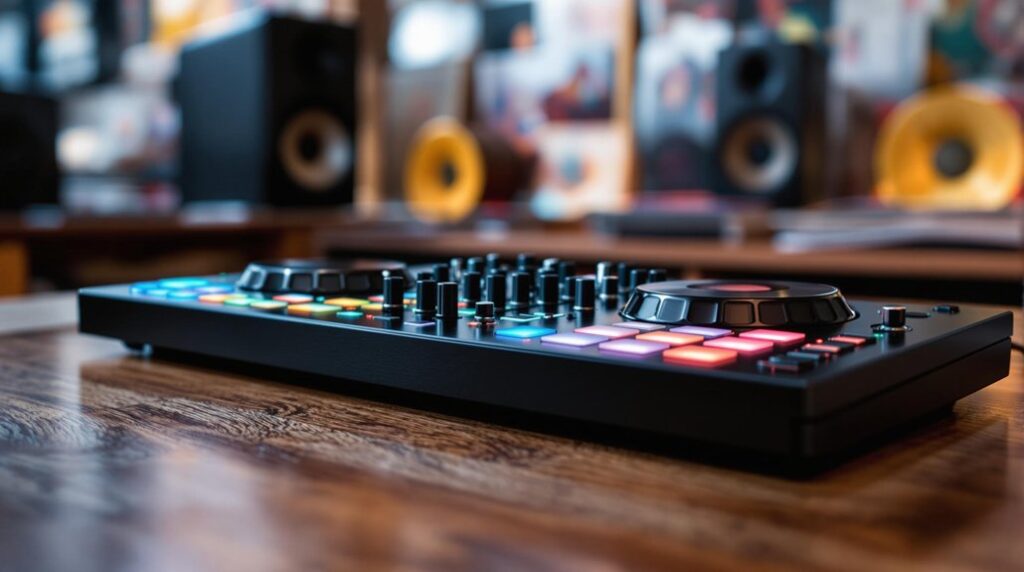Automatic BPM detection tools like DJ.Studio and Serato DJ Pro offer efficient and precise tempo analysis, essential for seamless beatmatching and enhanced music production. With features such as instant BPM results and key detection, these tools optimize music synchronization workflows. Using advanced algorithms facilitates accurate BPM identification across various audio formats. For musicians and DJs seeking to refine their performances and productions, these high-performing tools play an instrumental role in achieving accurate timing and engaging live sets. Learn further to explore more capabilities.
Key Takeaways
- DJ.Studio offers rapid BPM analysis with near-perfect accuracy in under 30 seconds.
- Automatic BPM detection tools provide quick and reliable results for various audio files.
- Online BPM calculators support multiple formats and ensure accurate tempo analysis.
- Serato DJ Pro and VirtualDJ are known for reliable live session performance.
- Practicing manual counting enhances rhythm and improves tempo detection skills.
Understanding BPM and Its Importance
Understanding BPM (beats per minute) is fundamental for anyone involved in music production and performance. BPM quantifies the tempo of a song by measuring how many beats occur within a 60-second interval. This metric is essential for musicians and DJs, as it guarantees accurate synchronization of tracks. To find BPM, one might use BPM detection tools that analyze the song BPM, providing vital data for seamless shifts and beatmatching. Different genres exhibit characteristic tempos; for instance, pop music typically ranges from 110–130 BPM, while electronic dance music spans 120–140 BPM. Accurate BPM detection is indispensable, as an incorrect BPM can disrupt recording and mixing processes, leading to timing discrepancies. Therefore, understanding BPM is key to maintaining musical rhythm and structure. DJs often rely on software with advanced BPM analysis to ensure precise beat matching and smooth transitions between tracks.
Manual Methods for BPM Counting
While BPM detection tools have become integral for modern music production, manual methods for BPM counting still hold significant value for musicians and producers seeking a deeper connection with rhythm and tempo.
Manual counting involves listening to the tempo of a song and using a stopwatch to time a specific number of beats, commonly over 60 seconds, to accurately Count BPM. For improved accuracy, shorter intervals, such as 15 or 30 seconds, can be utilized, multiplying the results accordingly.
Consistency in counting is essential, as distractions can lead to inaccuracies, especially in complex or fast-paced tracks. Despite the potential for human error, practicing manual counting enhances one's sense of rhythm and tempo, even across various common audio formats, ultimately honing BPM detection skills. Harmonic Mixing enhances the musical experience by ensuring tracks blend in compatible musical keys, which complements a DJ's ability to maintain a cohesive and rhythmic flow in their set.
Automatic Tools for BPM Detection
How do automatic BPM detection tools revolutionize tempo analysis in music production? They achieve nearly flawless BPM analysis in under 30 seconds, transforming how DJs and producers handle tempo. Automatic BPM detection tools like DJ.Studio and AI-powered solutions offer quick, reliable results for various audio files, including MP3, WAV, FLAC, and OGG. These BPM finder tools not only simplify tempo determination but also enhance productivity with bulk upload capabilities. Additionally, features such as key detection and noise reduction, available in tools like Vocal Remover and Audioalter, enrich the music analysis experience. User-friendly interfaces guarantee effortless navigation, streamlining workflows and enhancing precision in tempo measurement. Tools like Serato DJ Pro and VirtualDJ are known for their performance reliability, ensuring error-free performances during live sessions.
Utilizing DJ.Studio for Seamless Beatmatching
DJ.Studio revolutionizes the beatmatching process with its instantaneous BPM analysis, delivering near-perfect accuracy within 30 seconds. This feature greatly accelerates tempo synchronization for DJs. By enabling a drag-and-drop functionality for local audio files, it simplifies the workflow, making track synchronization both efficient and intuitive. Additionally, its integration with an extensive YouTube BPM database expands the repertoire available for seamless beatmatching, allowing for creative and fluid live performances. To ensure optimal performance on your DJing setup, consider optimizing Windows 10 by disabling unnecessary software and adjusting audio settings to enhance sound quality and system stability.
Instant BPM Analysis
Amidst the rapidly evolving environment of digital music production, how does one guarantee seamless beatmatching with pinpoint accuracy? DJ.Studio emerges as a formidable ally, offering instant BPM analysis that revolutionizes the DJing scene. Users can simply upload an audio file, triggering the software's swift BPM detection, which operates with nearly 100% accuracy in less than 30 seconds. As tools for analyzing tempo, DJ.Studio's tap tempo tool complements its automatic BPM detection capabilities, enabling DJs to engage in mixing without delay.
| Feature | Description |
|---|---|
| BPM Detection Speed | Under 30 seconds |
| Accuracy | Nearly 100% |
| File Upload Method | Drag and drop |
| Supported Platforms | YouTube, Spotify |
| User Interface | User-friendly for all skill levels |
This precise technology allows DJs to select tracks efficiently, enhancing the creative process with unparalleled ease.
Efficient Track Synchronization
Building upon the innovation of instant BPM analysis, the area of efficient track synchronization is revolutionized by DJ.Studio's seamless beatmatching capabilities.
This advanced software enables users to find the BPM with remarkable precision, boasting nearly 100% accuracy in under 30 seconds. DJs can efficiently synchronize tracks by simply dragging and dropping local files for instant analysis, facilitating a swift workflow.
DJ.Studio assists DJs in maintaining harmonious changes by organizing playlists with tempo differences of no more than 3-5 BPM. Furthermore, its integrated BPM database extends its utility to analyzing YouTube music and Spotify links, enhancing the scope for creative mixing.
The user-friendly interface guarantees accessibility for DJs of all levels, promoting effortless beatmatching without cumbersome manual calculations.
Analyzing Song Tempo With Precision
How accurately can song tempo be analyzed with modern tools? The answer lies in BPM finders that utilize advanced features to analyze audio files. These tools, such as DJ.Studio, offer near-perfect BPM detection within 30 seconds by employing sophisticated algorithms. This precision in analyzing songs tempo is indispensable for DJs and producers seeking smooth transitions and cohesive mixes. Unlike manual methods that often falter, automated software enhances workflow by rapidly determining BPM. With features like AI-powered mixing tools, DJ software programs continue to push the boundaries of creativity and efficiency in music analysis.
Top Free AI BPM Finder Tools
Revealing the innovative world of AI-driven BPM finder tools, the current environment offers a plethora of options tailored for precise tempo analysis.
These free online tools seamlessly estimate BPM (Beats Per Minute) and key from audio files, enhancing user experience.
- Vocal Remover: This tool efficiently estimates BPM, key, and Camelot, supports bulk uploads, and outputs results to CSV for streamlined analysis.
- Audioalter: Known for its quick BPM detection, it also includes noise reducers and pitch shifters, supporting formats like MP3 and WAV.
- Voice.ai: Provides rapid BPM and key detection, requiring no registration and delivering results within seconds.
- Raveon: Offers detailed BPM analysis with additional metrics, though it is more effective with longer tracks than short audio uploads.
Regularly explore new music sources to discover fresh tracks and maintain a vibrant library, ensuring your DJ sets stay dynamic and up-to-date.
Enhancing Your Music Experience With BPM Counters
Although frequently overlooked, BPM counters play an essential role in refining the auditory experience for DJs, musicians, and producers alike. These tools offer a swift determination of a track's BPM (Beats Per Minute), enabling seamless shifts and precise beatmatching. Online BPM calculators, such as DJ.Studio, boast near-perfect accuracy, analyzing a song's tempo in under 30 seconds. They support multiple audio formats, including MP3 and WAV, making the upload process effortless. By ensuring that playlists align with the perfect tempo, BPM counters enhance activities like dance and choreographed performances. Musicians and producers benefit greatly, as these tools help maintain the song key and prevent timing issues during production. Consequently, BPM counters are indispensable for achieving superior audio synchronization.
Frequently Asked Questions
How to Find BPM Pro Tools?
To determine BPM in Pro Tools, utilize tempo analysis techniques and beat matching strategies. Employ music production tools and digital audio workstations for precise BPM detection methods, ensuring accurate tempo alignment and fractional adjustments for seamless audio integration.
How to Find Out the BPM of a Beat?
To determine a beat's BPM, one can employ BPM calculation methods, utilizing tempo detection tools and audio analysis software. Beat matching techniques, alongside music production tips, enhance accuracy, offering precise tempo insights for diverse music genres.
How Can I Easily See What Tempo Is?
To easily determine tempo, individuals utilize tempo measurement techniques such as online BPM calculators, mobile BPM apps, and manual tapping methods. Visual tempo indicators further assist, providing instant BPM readings for precise musical analysis and mixing efficiency.
What Software Is Used to Calculate BPM?
BPM software specializes in tempo analysis, using advanced algorithms for rhythm measurement within digital audio. Essential for music production, these tools, like DJ.Studio, automate tempo detection, supporting various formats and enhancing workflow efficiency for producers and DJs.
Conclusion
In summary, accurately determining BPM is essential for various musical applications, from DJ beatmatching to precise tempo analysis. While manual counting methods provide foundational understanding, automatic tools offer efficiency and precision. Platforms like DJ.Studio seamlessly integrate BPM detection for enhanced music synchronization. Additionally, free AI-driven tools democratize access to sophisticated BPM analysis, empowering users to raise their musical experiences. As technology evolves, these tools continue to refine the art and science of rhythm management, ensuring a harmonious auditory journey.




